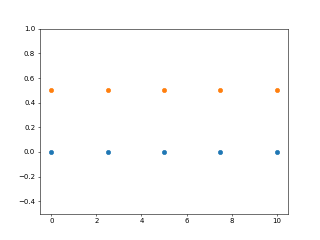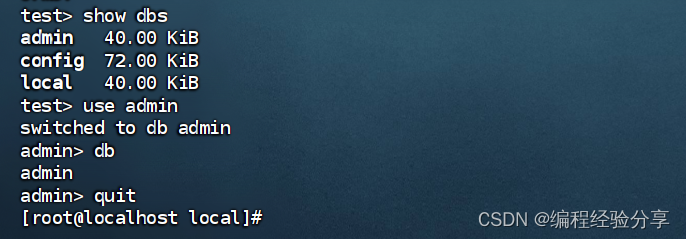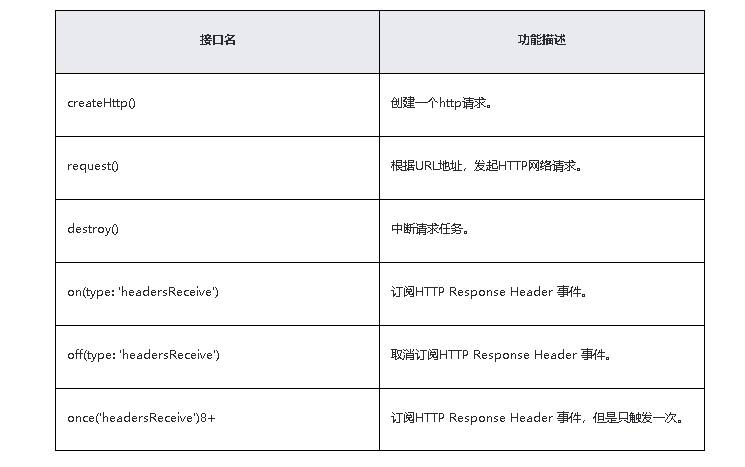一、Monitor 原理
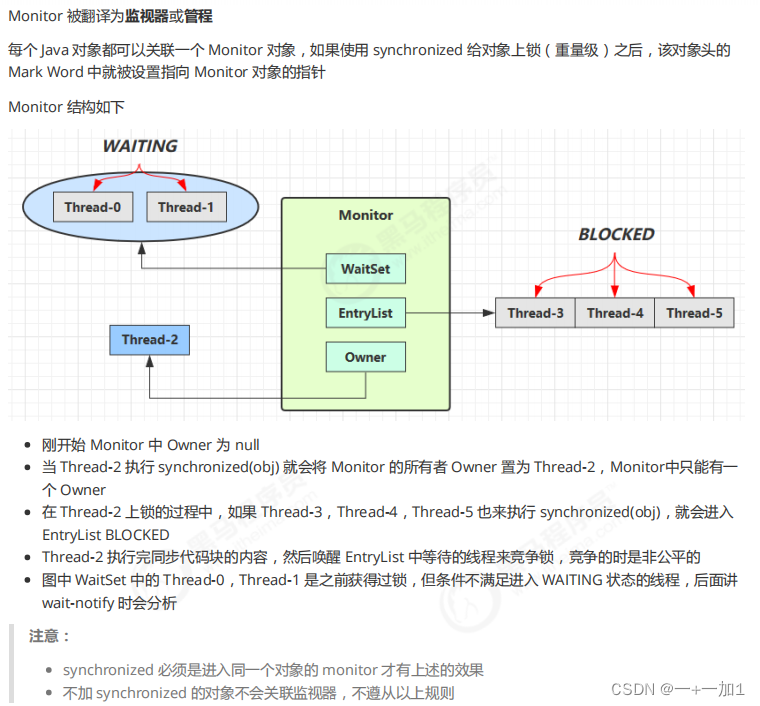
二、synchronized 原理
(一)、基础
synchronized 即使内部抛出异常也会释放锁
(二)、轻量级锁
static final Object obj = new Object();
public static void method1() {
synchronized( obj ) {
// 同步块 A
method2();
}
}
public static void method2() {
synchronized( obj ) {
// 同步块 B
}
}创建轻量级锁的过程
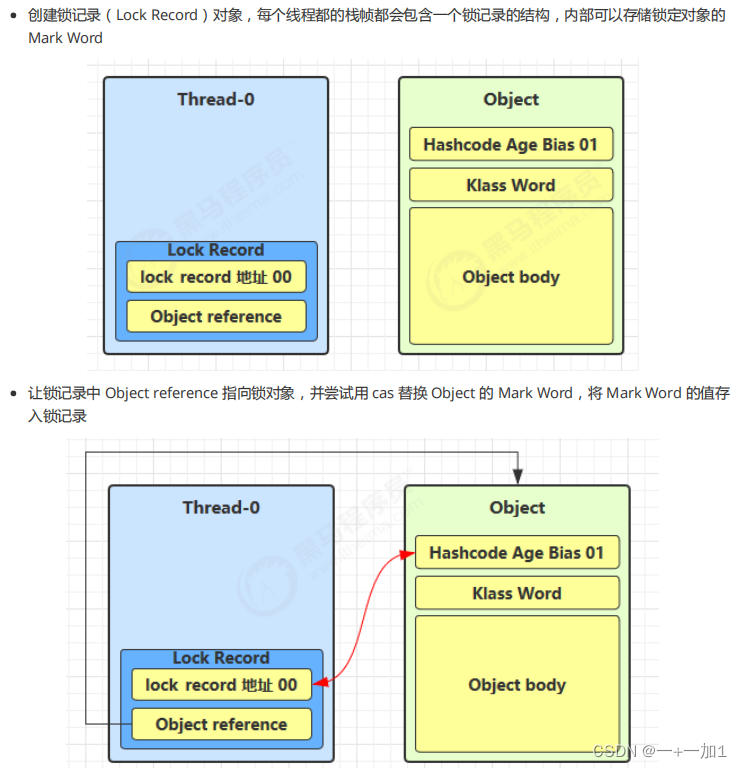


(三)、锁膨胀
当轻量级锁加锁失败时,会将轻量级锁升级为Monitor锁
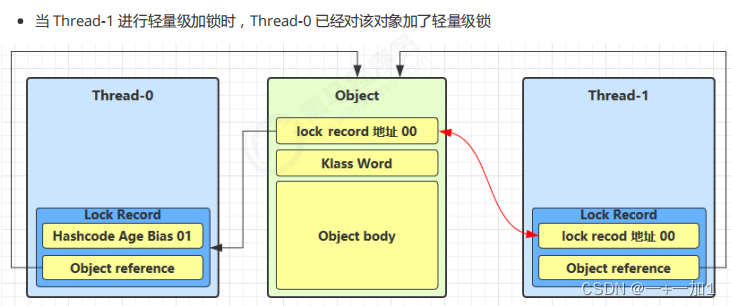
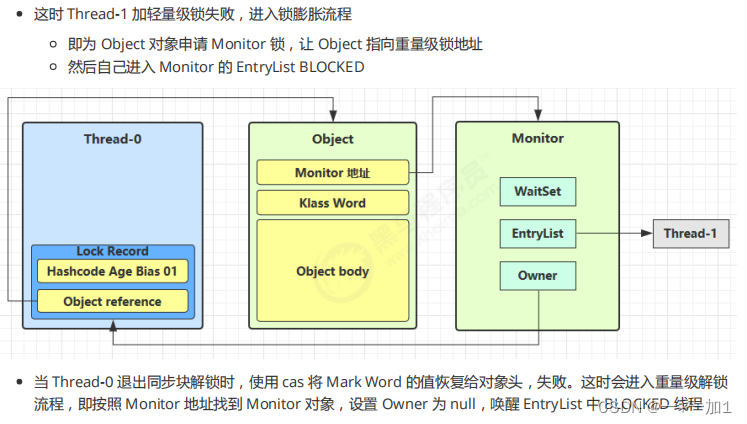
(三)、自旋优化
注意:
- 自旋会占用 CPU 时间,单核 CPU 自旋就是浪费,多核 CPU 自旋才能发挥优势。
- 在 Java 6 之后自旋锁是自适应的,比如对象刚刚的一次自旋操作成功过,那么认为这次自旋成功的可能性会高,就多自旋几次;反之,就少自旋甚至不自旋,总之,比较智能。
- Java 7 之后不能控制是否开启自旋功能
(四)、偏向锁
1、基本概念2
例如:
static final Object obj = new Object();
public static void m1() {
synchronized (obj) {
// 同步块 A
m2();
}
}
public static void m2() {
synchronized (obj) {
// 同步块 B
m3();
}
}
public static void m3() {
synchronized (obj) {
}
}|--------------------------------------------------------------------|--------------------|
| Mark Word (64 bits) | State |
|--------------------------------------------------------------------|--------------------|
| unused:25 | hashcode:31 | unused:1 | age:4 | biased_lock:0 | 01 | Normal |
|--------------------------------------------------------------------|--------------------|
| thread:54 | epoch:2 | unused:1 | age:4 | biased_lock:1 | 01 | Biased(偏向锁) |
|--------------------------------------------------------------------|--------------------|
| ptr_to_lock_record:62 | 00 | Lightweight Locked |
|--------------------------------------------------------------------|--------------------|
| ptr_to_heavyweight_monitor:62 | 10 | Heavyweight Locked |
|--------------------------------------------------------------------|--------------------|
| | 11 | Marked for GC |
|--------------------------------------------------------------------|--------------------|轻量级锁(00),存储锁记录的指针
重量级锁(10),存储重量级锁的指针
注意:
- 适用于单线程下用带锁的方法
- 如果开启了偏向锁(默认开启),那么对象创建后,markword 值为 0x05 即最后 3 位为 101,这时它的thread、epoch、age 都为 0
- 偏向锁是默认是延迟的,不会在程序启动时立即生效,如果想避免延迟,可以加 VM 参数 - XX:BiasedLockingStartupDelay=0 来禁用延迟
- 如果没有开启偏向锁,那么对象创建后,markword 值为 0x01 即最后 3 位为 001,这时它的 hashcode、 age 都为 0,第一次用到 hashcode 时才会赋
-
在代码运行时在添加 VM 参数 - XX: - UseBiasedLocking 禁用偏向锁
2、撤销偏向锁
(1)、调用了对象的 hashCode,但偏向锁的对象 MarkWord 中存储的是线程 id,如果调用 hashCode 会导致偏向锁被(为了存储hashcode没有地方存储线程id了)
- 轻量级锁会在锁记录中记录 hashCode
- 重量级锁会在 Monitor 中记录 hashCode
(2)、当有其它线程使用偏向锁对象时,会将偏向锁升级为轻量级锁(A线程加了偏向锁之后运行完成,然后B线程加锁)
(3)、使用wait/notify时
3、批量重偏向
private static void test3() throws InterruptedException {
Vector<Dog> list = new Vector<>();
Thread t1 = new Thread(() -> {
for (int i = 0; i < 30; i++) {
Dog d = new Dog();
list.add(d);
synchronized (d) {
log.debug(i + "\t" + ClassLayout.parseInstance(d).toPrintableSimple(true));
}
}
synchronized (list) {
list.notify();
}
}, "t1");
t1.start();
Thread t2 = new Thread(() -> {
synchronized (list) {
try {
list.wait();
} catch (InterruptedException e) {
e.printStackTrace();
}
}
log.debug("===============> ");
for (int i = 0; i < 30; i++) {
Dog d = list.get(i);
log.debug(i + "\t" + ClassLayout.parseInstance(d).toPrintableSimple(true));
synchronized (d) {
log.debug(i + "\t" + ClassLayout.parseInstance(d).toPrintableSimple(true));
}
log.debug(i + "\t" + ClassLayout.parseInstance(d).toPrintableSimple(true));
}
}, "t2");
t2.start();
}在t2线程中,前20次对象都是偏向线程t1的,但是撤销20次之后,剩下的对象全部偏向于t2线程。
批量重偏向不是批量执行的。而是说本来偏向锁只会偏向第一个锁定它的线程,之后再有线程就会是轻量锁。但因为撤销达到20次所以该类的对象当被锁定时再次被赋予偏向的能力。
4、批量撤销
5、锁消除
JIT对于热点代码进行优化,把不需要加锁但加了锁的地方进行优化
三、join原理
运用了模式中的保护性暂停
public final synchronized void join(long millis)throws InterruptedException {
long base = System.currentTimeMillis();
long now = 0;
if (millis < 0) {
throw new IllegalArgumentException("timeout value is negative");
}
if (millis == 0) {
while (isAlive()) {
wait(0);
}
} else {
while (isAlive()) {
long delay = millis - now;
if (delay <= 0) {
break;
}
wait(delay);
now = System.currentTimeMillis() - base;
}
}
}四、park/unpark
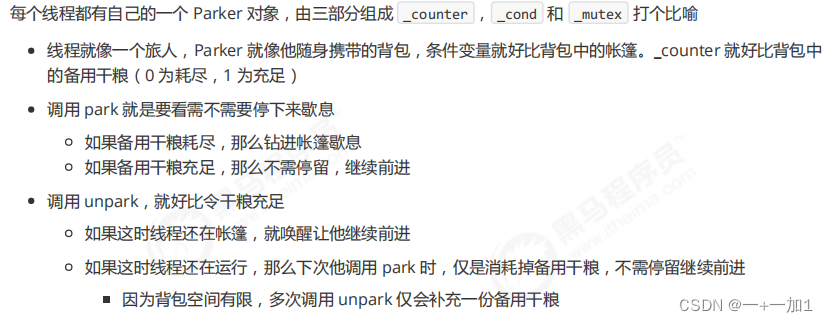
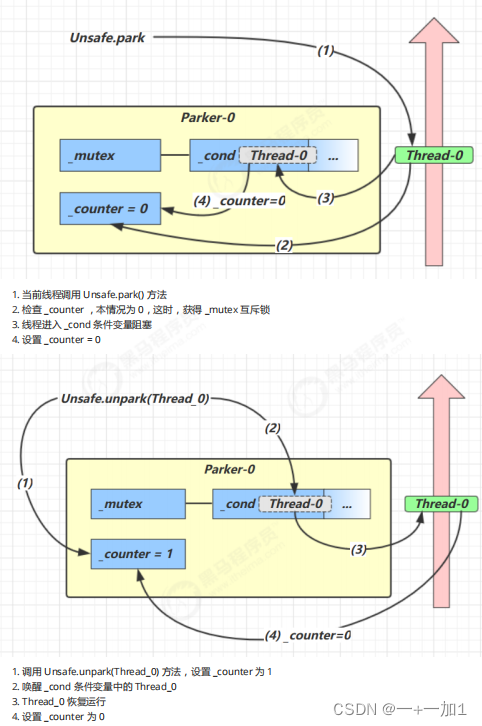
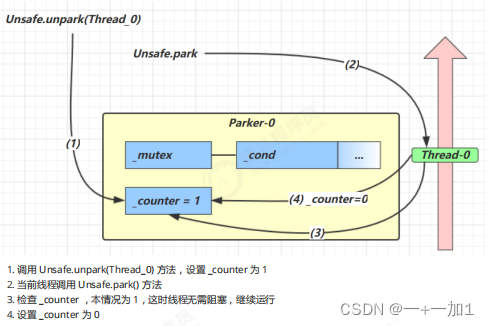
五、重新理解线程状态转换
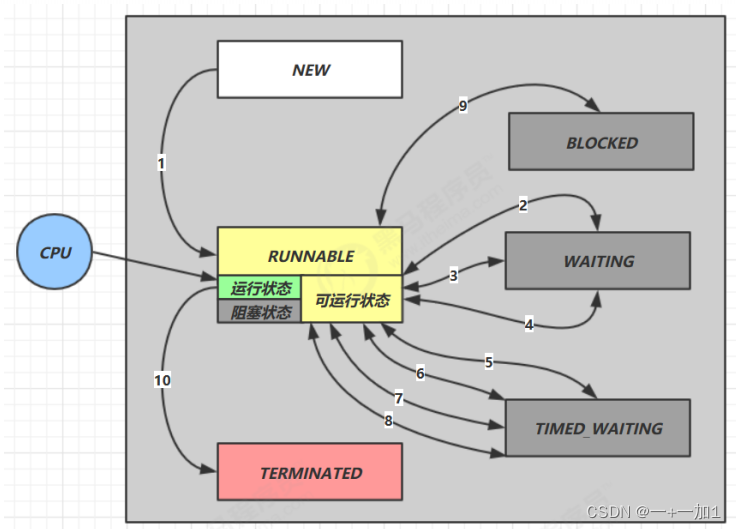
1 NEW --> RUNNABLE
2 RUNNABLE <--> WAITING
3 RUNNABLE <--> WAITING
4 RUNNABLE <--> WAITING
5 RUNNABLE <--> TIMED_WAITING
6 RUNNABLE <--> TIMED_WAITING
7 RUNNABLE <--> TIMED_WAITING
8 RUNNABLE <--> TIMED_WAITING
9 RUNNABLE <--> BLOCKED
10 RUNNABLE <--> TERMINATED
六、死锁
七、活锁
package com.itcast.test;
import lombok.extern.slf4j.Slf4j;
@Slf4j(topic = "c.Test7")
public class Test7 {
static volatile int count = 10;
static final Object lock = new Object();
public static void main(String[] args){
new Thread(() -> {
// 期望减到 0 退出循环
while (count > 0) {
try {
Thread.sleep(200);
} catch (InterruptedException e) {
e.printStackTrace();
}
count--;
log.debug("count: {}", count);
}
}, "t1").start();
new Thread(() -> {
// 期望超过 20 退出循环
while (count < 20) {
try {
Thread.sleep(200);
} catch (InterruptedException e) {
e.printStackTrace();
}
count++;
log.debug("count: {}", count);
}
}, "t2").start();
}
}
}八、饥饿
九、共享模型之内存
(一)、JMM
- 原子性 - 保证指令不会受到线程上下文切换的影响
- 可见性 - 保证指令不会受 cpu 缓存的影响
- 有序性 - 保证指令不会受 cp
(二)、可见性(volatile)
static boolean run = true;
public static void main(String[] args) throws InterruptedException {
Thread t = new Thread(()->{
while(run){
// ....
}
});
t.start();
sleep(1);
run = false; // 线程t不会如预想的停下来
}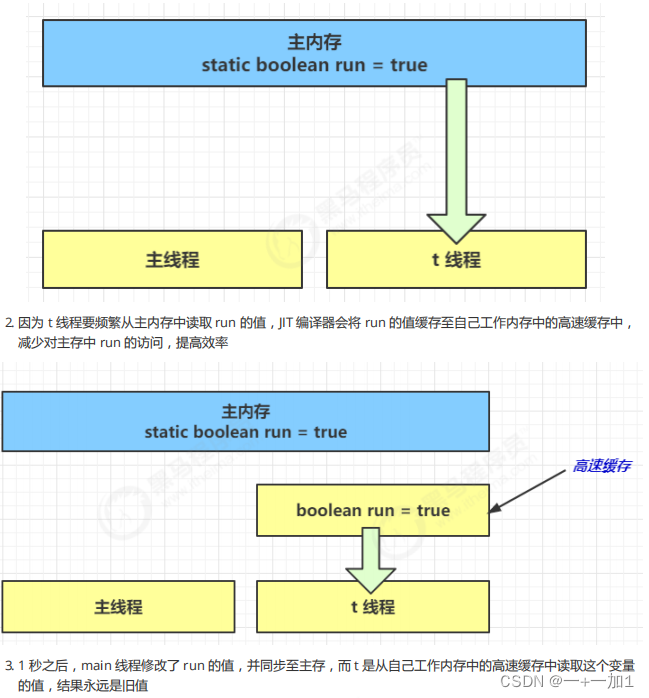
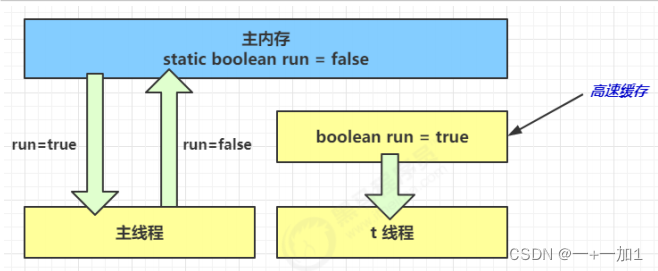
解决方法
volatile static boolean run = true;注意:如果对改为
while(true){
synchronized(this){
if(!run) break;
}
}加了锁之后,不用加volatile也可以
(三)、有序性
1、指令重排
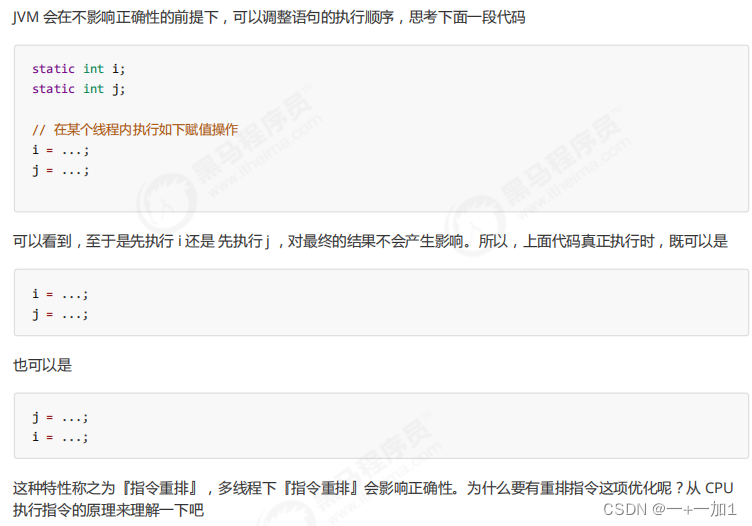
2、出错的结果
int num = 0;
boolean ready = false;
// 线程1 执行此方法
public void actor1(I_Result r) {
if(ready) {
r.r1 = num + num;
} else {
r.r1 = 1;
}
}
// 线程2 执行此方法
public void actor2(I_Result r) {
num = 2;
ready = true;
}如果actor2发生了指令重排,有可能结果会出现等于0的情况
3、解决方法
volatile boolean ready = false;将ready添加volatile关键字,可以防止ready前面的指令发生重排,所以不需要将num也添加volatile关键字
十、volatile原理
(一)、如何保证可见性
public void actor2(I_Result r) {
num = 2;
ready = true; // ready 是 volatile 赋值带写屏障
// 写屏障
}public void actor1(I_Result r) {
// 读屏障
// ready 是 volatile 读取值带读屏障
if(ready) {
r.r1 = num + num;
} else {
r.r1 = 1;
}
}(二)、如何保证有序性
public void actor2(I_Result r) {
num = 2;
ready = true; // ready 是 volatile 赋值带写屏障
// 写屏障
}public void actor1(I_Result r) {
// 读屏障
// ready 是 volatile 读取值带读屏障
if(ready) {
r.r1 = num + num;
} else {
r.r1 = 1;
}
}(三)、double-checked locking 问题
public final class Singleton {
private Singleton() { }
private static Singleton INSTANCE = null;
public static Singleton getInstance() {
if(INSTANCE == null) { // t2
// 首次访问会同步,而之后的使用没有 synchronized
synchronized(Singleton.class) {
if (INSTANCE == null) { // t1
INSTANCE = new Singleton();
}
}
}
return INSTANCE;
}
}(四)、double-checked locking 解决
private static volatile Singleton INSTANCE = null;(五)、happens-before
十一、LongAdder原理
// 累加单元数组, 懒惰初始化
transient volatile Cell[] cells;
// 基础值, 如果没有竞争, 则用 cas 累加这个域
transient volatile long base;
// 在 cells 创建或扩容时, 置为 1, 表示加锁
transient volatile int cellsBusy;(一)、cas锁
// 不要用于实践!!!
public class LockCas {
private AtomicInteger state = new AtomicInteger(0);
public void lock() {
while (true) {
if (state.compareAndSet(0, 1)) {
break;
}
}
}
public void unlock() {
log.debug("unlock...");
state.set(0);
}
}测试
LockCas lock = new LockCas();
new Thread(() -> {
log.debug("begin...");
lock.lock();
try {
log.debug("lock...");
sleep(1);
} finally {
lock.unlock();
}
}).start();
new Thread(() -> {
log.debug("begin...");
lock.lock();
try {
log.debug("lock...");
} finally {
lock.unlock();
}
}).start();(二)、原理之伪共享
// 防止缓存行伪共享
@sun.misc.Contended
static final class Cell {
volatile long value;
Cell(long x) { value = x; }
// 最重要的方法, 用来 cas 方式进行累加, prev 表示旧值, next 表示新值
final boolean cas(long prev, long next) {
return UNSAFE.compareAndSwapLong(this, valueOffset, prev, next);
}
// 省略不重要代码
}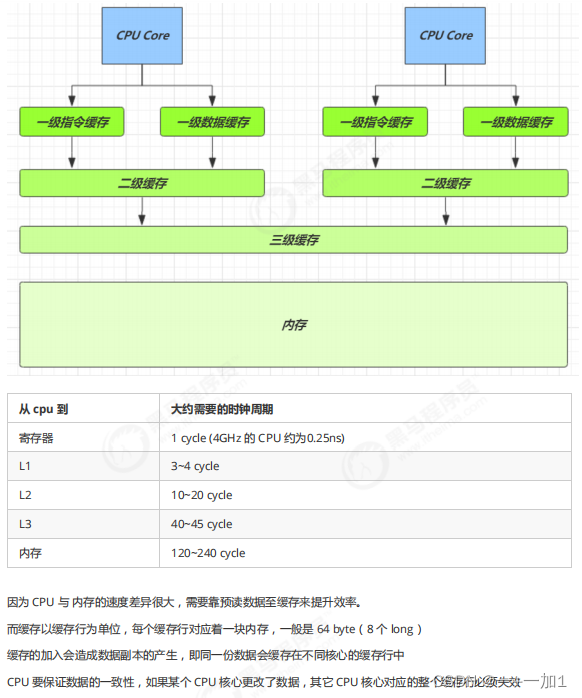
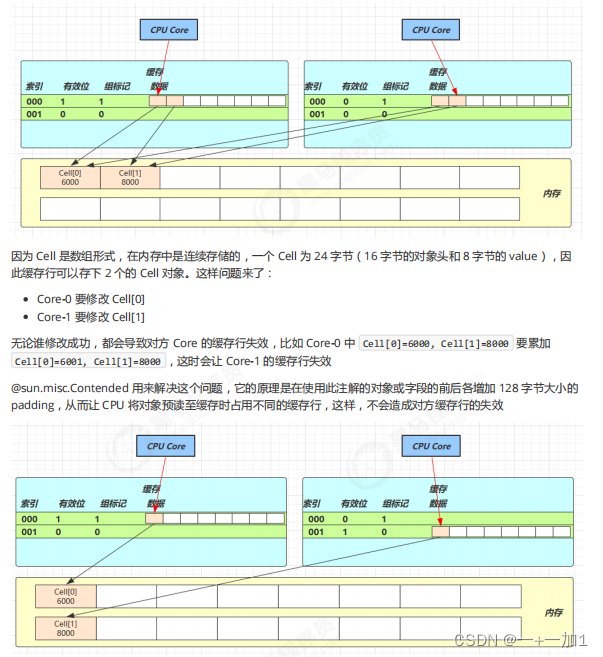
public void add(long x) {
// as 为累加单元数组
// b 为基础值
// x 为累加值
Cell[] as;
long b, v;
int m;
Cell a;
// 进入 if 的两个条件
// 1. as 有值, 表示已经发生过竞争, 进入 if
// 2. cas 给 base 累加时失败了, 表示 base 发生了竞争, 进入 if
if ((as = cells) != null || !casBase(b = base, b + x)) {
// uncontended 表示 cell 没有竞争
boolean uncontended = true;
if (
// as 还没有创建
as == null || (m = as.length - 1) < 0 ||
// 当前线程对应的 cell 还没有
(a = as[getProbe() & m]) == null ||
// cas 给当前线程的 cell 累加失败 uncontended=false ( a 为当前线程的 cell )
!(uncontended = a.cas(v = a.value, v + x))
) {
// 进入 cell 数组创建、cell 创建的流程
longAccumulate(x, null, uncontended);
}
}
}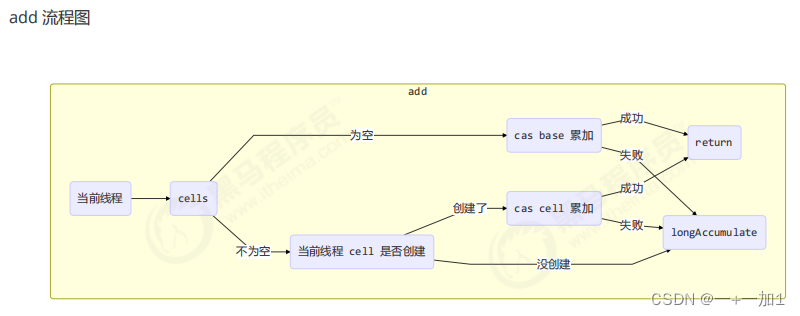
final void longAccumulate(long x, LongBinaryOperator fn,
boolean wasUncontended) {
int h;
// 当前线程还没有对应的 cell, 需要随机生成一个 h 值用来将当前线程绑定到 cell
if ((h = getProbe()) == 0) {
// 初始化 probe
ThreadLocalRandom.current();
// h 对应新的 probe 值, 用来对应 cell
h = getProbe();
wasUncontended = true;
}
// collide 为 true 表示需要扩容
boolean collide = false;
for (; ; ) {
Cell[] as;
Cell a;
int n;
long v;
// 已经有了 cells
if ((as = cells) != null && (n = as.length) > 0) {
// 还没有 cell
if ((a = as[(n - 1) & h]) == null) {
// 为 cellsBusy 加锁, 创建 cell, cell 的初始累加值为 x
// 成功则 break, 否则继续 continue 循环
}
// 有竞争, 改变线程对应的 cell 来重试 cas
else if (!wasUncontended)
wasUncontended = true;
// cas 尝试累加, fn 配合 LongAccumulator 不为 null, 配合 LongAdder 为 null
else if (a.cas(v = a.value, ((fn == null) ? v + x : fn.applyAsLong(v, x))))
break;
// 如果 cells 长度已经超过了最大长度, 或者已经扩容, 改变线程对应的 cell 来重试 cas
else if (n >= NCPU || cells != as)
collide = false;
// 确保 collide 为 false 进入此分支, 就不会进入下面的 else if 进行扩容了
else if (!collide)
collide = true;
// 加锁
else if (cellsBusy == 0 && casCellsBusy()) {
// 加锁成功, 扩容
continue;
}
// 改变线程对应的 cell
h = advanceProbe(h);
}
// 还没有 cells, 尝试给 cellsBusy 加锁
else if (cellsBusy == 0 && cells == as && casCellsBusy()) {
// 加锁成功, 初始化 cells, 最开始长度为 2, 并填充一个 cell
// 成功则 break;
}
// 上两种情况失败, 尝试给 base 累加
else if (casBase(v = base, ((fn == null) ? v + x : fn.applyAsLong(v, x))))
break;
}
}
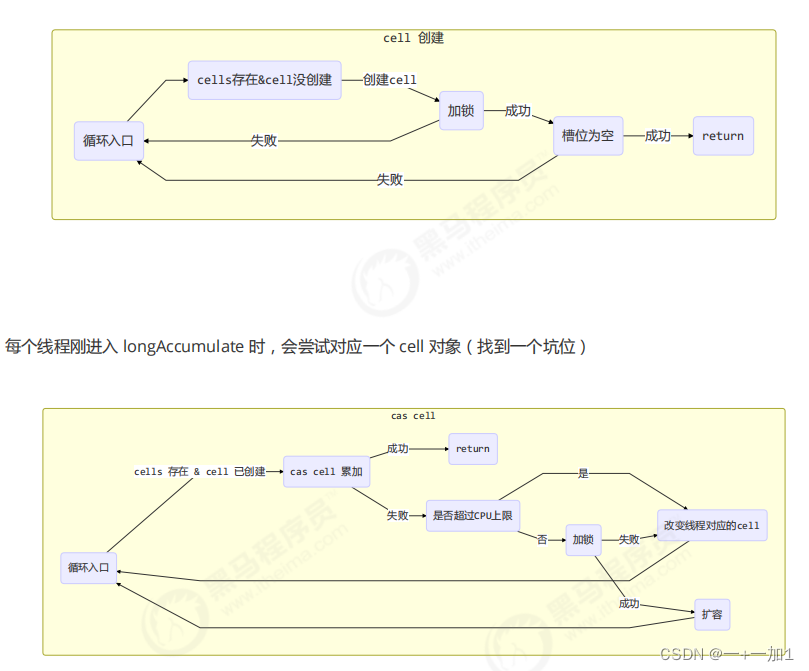
public long sum() {
Cell[] as = cells; Cell a;
long sum = base;
if (as != null) {
for (int i = 0; i < as.length; ++i) {
if ((a = as[i]) != null)
sum += a.value;
}
}
return sum;
}十二、不可变设计
string
public final class String
implements java.io.Serializable, Comparable<String>, CharSequence {
/** The value is used for character storage. */
private final char value[];
/** Cache the hash code for the string */
private int hash; // Default to 0
// ...
}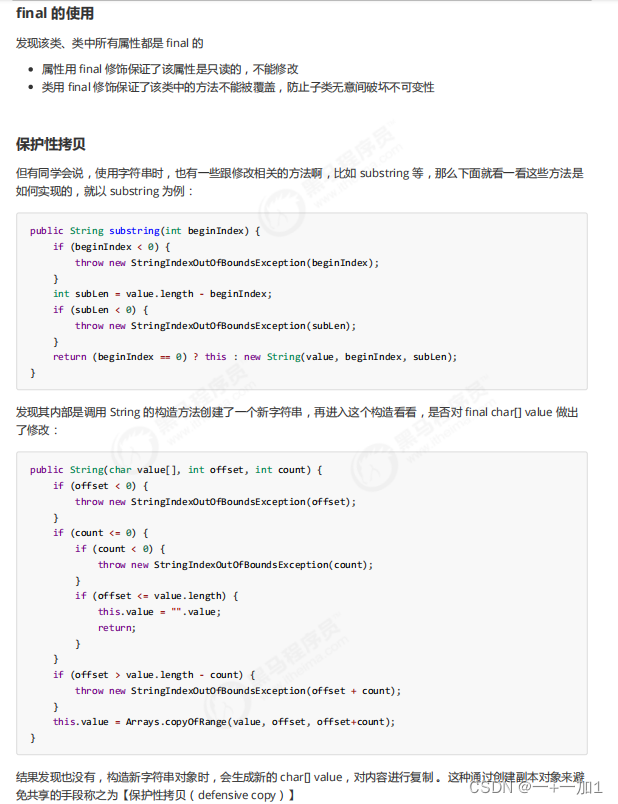
十三、final原理
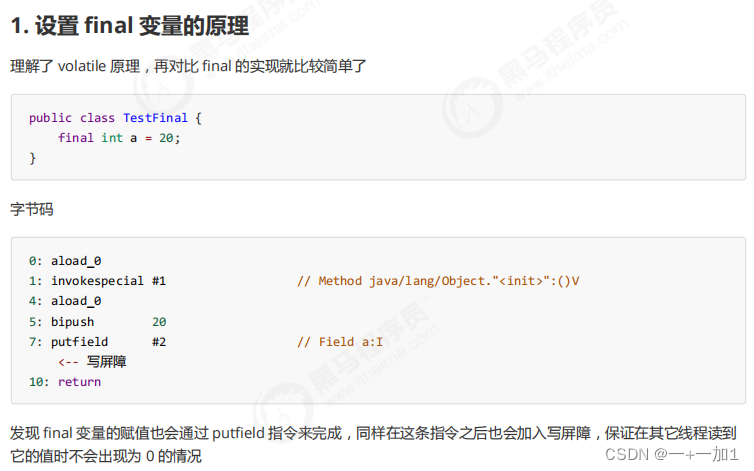
十四、AQS原理
(一)、概述
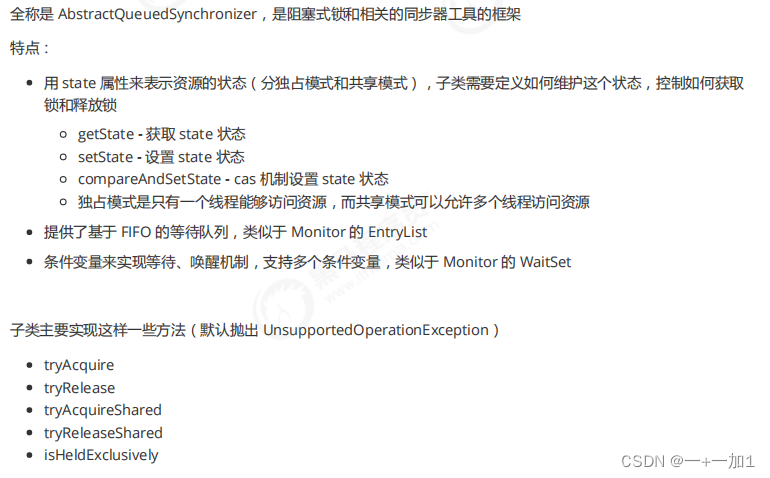
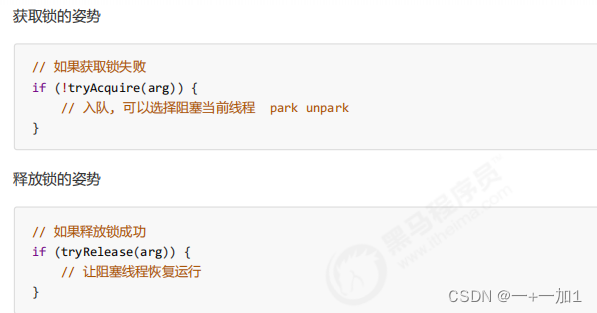
(二)、实现不可重入锁
final class MySync extends AbstractQueuedSynchronizer {
@Override
protected boolean tryAcquire(int acquires) {
if (acquires == 1) {
if (compareAndSetState(0, 1)) {
setExclusiveOwnerThread(Thread.currentThread());
return true;
}
}
return false;
}
@Override
protected boolean tryRelease(int acquires) {
if (acquires == 1) {
if (getState() == 0) {
throw new IllegalMonitorStateException();
}
setExclusiveOwnerThread(null);
setState(0);
return true;
}
return false;
}
protected Condition newCondition() {
return new ConditionObject();
}
@Override
protected boolean isHeldExclusively() {
return getState() == 1;
}
}class MyLock implements Lock {
static MySync sync = new MySync();
@Override
// 尝试,不成功,进入等待队列
public void lock() {
sync.acquire(1);
}
@Override
// 尝试,不成功,进入等待队列,可打断
public void lockInterruptibly() throws InterruptedException {
sync.acquireInterruptibly(1);
}
@Override
// 尝试一次,不成功返回,不进入队列
public boolean tryLock() {
return sync.tryAcquire(1);
}
@Override
// 尝试,不成功,进入等待队列,有时限
public boolean tryLock(long time, TimeUnit unit) throws InterruptedException {
return sync.tryAcquireNanos(1, unit.toNanos(time));
}
@Override
// 释放锁
public void unlock() {
sync.release(1);
}
@Override
// 生成条件变量
public Condition newCondition() {
return sync.newCondition();
}
}十五、ReentrantLock 原理
(一)、非公平锁实现原理
1、加锁解锁流程
public ReentrantLock() {
sync = new NonfairSync();
}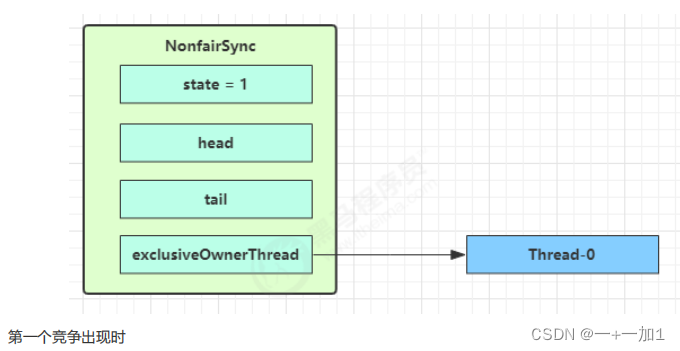



加锁流程
- 构造器构造,默认构造非公平锁
- (无竞争,第一个线程尝试加锁时)加锁,luck(),
final void lock() { // 首先用 cas 尝试(仅尝试一次)将 state 从 0 改为 1, 如果成功表示获得了独占锁 if (compareAndSetState(0, 1)) setExclusiveOwnerThread(Thread.currentThread()); else // 如果尝试失败,进入 ㈠ acquire(1); }首先尝试将锁的state改为1,如果修改成功,则将拥有锁的线程修改位为当前线程

- 当第一个竞争线程出现时,竞争线程尝试加锁,无法将state由0改为1,竞争线程进入方法acquire(1);
// ㈠ AQS 继承过来的方法, 方便阅读, 放在此处 public final void acquire(int arg) { // ㈡ tryAcquire if ( !tryAcquire(arg) && // 当 tryAcquire 返回为 false 时, 先调用 addWaiter ㈣, 接着 acquireQueued ㈤ acquireQueued(addWaiter(Node.EXCLUSIVE), arg) ) { selfInterrupt(); } } - 线程进入tryAcquire(arg)方法,再次尝试加锁,如果成功 !(tryAcquire(arg)) = false,退出流程,加锁成功
- 再次加锁失败!(tryAcquire(arg)) = true,进入 acquireQueued(addWaiter(Node.EXCLUSIVE), arg)方法
- 先执行addWaiter(Node.EXCLUSIVE)方法,该方法是构造 Node 队列,在第一个竞争线程执行该方法时,除了创造关联本线程的节点,还会创造一个哑元节点(该节点就是列表的head节点,NonfairSync中的head也指向该节点),默认初始状态都为0,形成双向列表,返回值时关联竞争线程的那个Node节点

- 执行acquireQueued(addWaiter(Node.EXCLUSIVE), arg)方法,
// AQS 继承过来的方法, 方便阅读, 放在此处 final boolean acquireQueued(final Node node, int arg) { boolean failed = true; try { boolean interrupted = false; for (; ; ) { final Node p = node.predecessor(); // 上一个节点是 head, 表示轮到自己(当前线程对应的 node)了, 尝试获取 if (p == head && tryAcquire(arg)) { // 获取成功, 设置自己(当前线程对应的 node)为 head setHead(node); // 上一个节点 help GC p.next = null; failed = false; // 返回中断标记 false return interrupted; } if ( // 判断是否应当 park, 进入 ㈦ shouldParkAfterFailedAcquire(p, node) && // park 等待, 此时 Node 的状态被置为 Node.SIGNAL ㈧ parkAndCheckInterrupt() ) { interrupted = true; } } } finally { if (failed) cancelAcquire(node); } } -
进入到for(;;)循环,找出当前节点的前驱节点定义为p,此时p就是哑元节点,此时 p == head,再次尝试获取锁(如果当前节点是排在第二位的节点,就可以尝试再次加锁),如果尝试加锁成功
-
尝试加锁失败,执行
if( // 判断是否应当 park, 进入 ㈦ shouldParkAfterFailedAcquire(p,node)&& // park 等待, 此时 Node 的状态被置为 Node.SIGNAL ㈧ parkAndCheckInterrupt() ){ interrupted=true; } -
执行shouldParkAfterFailedAcquire(p,node)方法
// AQS 继承过来的方法, 方便阅读, 放在此处 private static boolean shouldParkAfterFailedAcquire(Node pred, Node node) { // 获取上一个节点的状态 int ws = pred.waitStatus; if (ws == Node.SIGNAL) { //Node.SIGNAL = -1 // 上一个节点都在阻塞, 那么自己也阻塞好了 return true; } // > 0 表示取消状态 if (ws > 0) { // 上一个节点取消, 那么重构删除前面所有取消的节点, 返回到外层循环重试 do { node.prev = pred = pred.prev; } while (pred.waitStatus > 0); pred.next = node; } else { // 这次还没有阻塞 // 但下次如果重试不成功, 则需要阻塞,这时需要设置上一个节点状态为 Node.SIGNAL compareAndSetWaitStatus(pred, ws, Node.SIGNAL); } return false; } -
由于pred(p)的状态=0,所以进入compareAndSetWaitStatus(pred, ws, Node.SIGNAL),该方法时将pred(p)的状态改为-1,结束方法,返回false
-
回到之前的代码,进行下一次循环,再次执行if (p == head && tryAcquire(arg)),再次尝试加锁,如果成功,...... ,失败,进入
if( // 判断是否应当 park, 进入 ㈦ shouldParkAfterFailedAcquire(p,node)&& // park 等待, 此时 Node 的状态被置为 Node.SIGNAL ㈧ parkAndCheckInterrupt() ){ interrupted=true; }// AQS 继承过来的方法, 方便阅读, 放在此处 final boolean acquireQueued(final Node node, int arg) { boolean failed = true; try { boolean interrupted = false; for (; ; ) { final Node p = node.predecessor(); // 上一个节点是 head, 表示轮到自己(当前线程对应的 node)了, 尝试获取 if (p == head && tryAcquire(arg)) { // 获取成功, 设置自己(当前线程对应的 node)为 head setHead(node); // 上一个节点 help GC p.next = null; failed = false; // 返回中断标记 false return interrupted; } if ( // 判断是否应当 park, 进入 ㈦ shouldParkAfterFailedAcquire(p, node) && // park 等待, 此时 Node 的状态被置为 Node.SIGNAL ㈧ parkAndCheckInterrupt() ) { interrupted = true; } } } finally { if (failed) cancelAcquire(node); } } -
再次进入shouldParkAfterFailedAcquire(p,node),此时prep(p) = -1,返回true
// AQS 继承过来的方法, 方便阅读, 放在此处 private static boolean shouldParkAfterFailedAcquire(Node pred, Node node) { // 获取上一个节点的状态 int ws = pred.waitStatus; if (ws == Node.SIGNAL) { //Node.SIGNAL = -1 // 上一个节点都在阻塞, 那么自己也阻塞好了 return true; } // > 0 表示取消状态 if (ws > 0) { // 上一个节点取消, 那么重构删除前面所有取消的节点, 返回到外层循环重试 do { node.prev = pred = pred.prev; } while (pred.waitStatus > 0); pred.next = node; } else { // 这次还没有阻塞 // 但下次如果重试不成功, 则需要阻塞,这时需要设置上一个节点状态为 Node.SIGNAL compareAndSetWaitStatus(pred, ws, Node.SIGNAL); } return false; } -
进入parkAndCheckInterrupt()方法,当前线程进入阻塞状态
// 阻塞当前线程 private final boolean parkAndCheckInterrupt() { LockSupport.park(this); return Thread.interrupted(); }
-
多个线程竞争失败后,

-
此时,Thread-0执行完成,释放锁,调用ReentrantLock中的
public void unlock() { sync.release(1); } -
进入sync.release(1)方法,
public final boolean release(int arg) { if (tryRelease(arg)) { AbstractQueuedSynchronizer.Node h = head; if (h != null && h.waitStatus != 0) unparkSuccessor(h); return true; } return false; }在tryRelease(arg)方法中,设置 exclusiveOwnerThread 为 null,state = 0,返回true(返回false 的情况下面再说)

-
执行到
AbstractQueuedSynchronizer.Node h = head; if (h != null && h.waitStatus != 0) unparkSuccessor(h); -
此时h = head 不等于null,且h的状态!=0 (等于-1),进入unparkSuccessor(h)方法,唤醒后继节点,此时node (h) 的状态=-1,h的后继节(s)点 != null,执行 if (s != null) LockSupport.unpark(s.thread); 唤醒s线程,s线程开始竞争锁
private void unparkSuccessor(AbstractQueuedSynchronizer.Node node) { /* * If status is negative (i.e., possibly needing signal) try * to clear in anticipation of signalling. It is OK if this * fails or if status is changed by waiting thread. */ int ws = node.waitStatus; if (ws < 0) compareAndSetWaitStatus(node, ws, 0); /* * Thread to unpark is held in successor, which is normally * just the next node. But if cancelled or apparently null, * traverse backwards from tail to find the actual * non-cancelled successor. */ AbstractQueuedSynchronizer.Node s = node.next; if (s == null || s.waitStatus > 0) { s = null; for (AbstractQueuedSynchronizer.Node t = tail; t != null && t != node; t = t.prev) if (t.waitStatus <= 0) s = t; } if (s != null) LockSupport.unpark(s.thread); } -
s(Thread-1)线程回到
// 阻塞当前线程 private final boolean parkAndCheckInterrupt() { LockSupport.park(this); return Thread.interrupted(); }继续执行
-
返回到
// AQS 继承过来的方法, 方便阅读, 放在此处 final boolean acquireQueued(final Node node, int arg) { boolean failed = true; try { boolean interrupted = false; for (; ; ) { final Node p = node.predecessor(); // 上一个节点是 head, 表示轮到自己(当前线程对应的 node)了, 尝试获取 if (p == head && tryAcquire(arg)) { // 获取成功, 设置自己(当前线程对应的 node)为 head setHead(node); // 上一个节点 help GC p.next = null; failed = false; // 返回中断标记 false return interrupted; } if ( // 判断是否应当 park, 进入 ㈦ shouldParkAfterFailedAcquire(p, node) && // park 等待, 此时 Node 的状态被置为 Node.SIGNAL ㈧ parkAndCheckInterrupt() ) { interrupted = true; } } } finally { if (failed) cancelAcquire(node); } }继续进行for循环,此时if (p == head && tryAcquire(arg)) ,在次尝试加锁,此时如果加锁成功,执行以下代码
setHead(node); // 上一个节点 help GC p.next = null; failed = false; // 返回中断标记 false return interrupted;将关联s线程(刚才关联Thread-1线程的节点)的节点设置为头节点(删除之前的头节点,将此节点关联的线程改为null)

-
如果刚才thread-1线程唤醒后,新出现了一个线程与之竞争,且thread-1线程竞争失败,在次进入parkAndCheckInterrupt(),进入阻塞状态

2、可重入原理
ReentrantLock的非公平获取锁的源码
protected final boolean tryAcquire(int acquires) {
return nonfairTryAcquire(acquires);
}static final class NonfairSync extends Sync {
// ...
// Sync 继承过来的方法, 方便阅读, 放在此处
final boolean nonfairTryAcquire(int acquires) {
final Thread current = Thread.currentThread();
int c = getState();
if (c == 0) {
if (compareAndSetState(0, acquires)) {
setExclusiveOwnerThread(current);
return true;
}
}
// 如果已经获得了锁, 线程还是当前线程, 表示发生了锁重入
else if (current == getExclusiveOwnerThread()) {
// state++
int nextc = c + acquires;
if (nextc < 0) // overflow
throw new Error("Maximum lock count exceeded");
setState(nextc);
return true;
}
return false;
}
// Sync 继承过来的方法, 方便阅读, 放在此处
protected final boolean tryRelease(int releases) {
// state--
int c = getState() - releases;
if (Thread.currentThread() != getExclusiveOwnerThread())
throw new IllegalMonitorStateException();
boolean free = false;
// 支持锁重入, 只有 state 减为 0, 才释放成功
if (c == 0) {
free = true;
setExclusiveOwnerThread(null);
}
setState(c);
return free;
}
}
- 当一个线程第一次获得锁时,进入代码
if (c == 0) { if (compareAndSetState(0, acquires)) { setExclusiveOwnerThread(current); return true; } }把锁的state设置为1,把拥有锁的线程设置为当前线程,返回true
- 当一个线程多次获得锁时(锁重入),进入代码
else if (current == getExclusiveOwnerThread()) { // state++ int nextc = c + acquires; if (nextc < 0) // overflow throw new Error("Maximum lock count exceeded"); setState(nextc); return true; }让state++,返回true
- 当锁重入后释放锁时,进入
protected final boolean tryRelease(int releases) { // state-- int c = getState() - releases; if (Thread.currentThread() != getExclusiveOwnerThread()) throw new IllegalMonitorStateException(); boolean free = false; // 支持锁重入, 只有 state 减为 0, 才释放成功 if (c == 0) { free = true; setExclusiveOwnerThread(null); } setState(c); return free; }让state--,如果state != 0 返回false,如果=0,设置当前拥有锁的线程为null,返回true
3、可打断原理
(1)、不可打断(默认)
// Sync 继承自 AQS
static final class NonfairSync extends Sync {
// ...
private final boolean parkAndCheckInterrupt() {
// 如果打断标记已经是 true, 则 park 会失效
LockSupport.park(this);
// interrupted 会清除打断标记
return Thread.interrupted();
}
final boolean acquireQueued(final Node node, int arg) {
boolean failed = true;
try {
boolean interrupted = false;
for (; ; ) {
final Node p = node.predecessor();
if (p == head && tryAcquire(arg)) {
setHead(node);
p.next = null;
failed = false;
// 还是需要获得锁后, 才能返回打断状态
return interrupted;
}
if (
shouldParkAfterFailedAcquire(p, node) &&
parkAndCheckInterrupt()
) {
// 如果是因为 interrupt 被唤醒, 返回打断状态为 true
interrupted = true;
}
}
} finally {
if (failed)
cancelAcquire(node);
}
}
public final void acquire(int arg) {
if (
!tryAcquire(arg) &&
acquireQueued(addWaiter(Node.EXCLUSIVE), arg)
) {
// 如果打断状态为 true
selfInterrupt();
}
}
static void selfInterrupt() {
// 重新产生一次中断
Thread.currentThread().interrupt();
}
}- 被打断后,进入方法,return true,但是Thread.interrupted()会重置打断标记为false
// 阻塞当前线程 private final boolean parkAndCheckInterrupt() { LockSupport.park(this); return Thread.interrupted(); } -
回退到
if ( shouldParkAfterFailedAcquire(p, node) && parkAndCheckInterrupt() ) { // 如果是因为 interrupt 被唤醒, 返回打断状态为 true interrupted = true; }置interrupted = true
-
接着循环,接着进入到
// 阻塞当前线程 private final boolean parkAndCheckInterrupt() { LockSupport.park(this); return Thread.interrupted(); }进入阻塞状态,但再次被唤醒之后器其返回值仍然时true
-
直到该线程获得所之后,执行
if (p == head && tryAcquire(arg)) { setHead(node); p.next = null; failed = false; // 还是需要获得锁后, 才能返回打断状态 return interrupted; }返回true
-
回退到
public final void acquire(int arg) { if ( !tryAcquire(arg) && acquireQueued(addWaiter(Node.EXCLUSIVE), arg) ) { // 如果打断状态为 true selfInterrupt(); } } static void selfInterrupt() { // 重新产生一次中断 Thread.currentThread().interrupt(); }acquireQueued(addWaiter(Node.EXCLUSIVE), arg)返回值时true,执行selfInterrupted(),打断当前进程
在不可打断模式下,只要任务在AQS队列中,就不能打断
(2)、可打断
// ㈠ 可打断的获取锁流程
private void doAcquireInterruptibly(int arg) throws InterruptedException {
final Node node = addWaiter(Node.EXCLUSIVE);
boolean failed = true;
try {
for (;;) {
final Node p = node.predecessor();
if (p == head && tryAcquire(arg)) {
setHead(node);
p.next = null; // help GC
failed = false;
return;
}
if (shouldParkAfterFailedAcquire(p, node) &&
parkAndCheckInterrupt()) {
// 在 park 过程中如果被 interrupt 会进入此
// 这时候抛出异常, 而不会再次进入 for (;;)
throw new InterruptedException();
}
}
} finally {
if (failed)
cancelAcquire(node);
}
}打断后直接抛出异常
(二)、公平锁实现原理
static final class FairSync extends Sync {
private static final long serialVersionUID = -3000897897090466540L;
final void lock() {
acquire(1);
}
// AQS 继承过来的方法, 方便阅读, 放在此处
public final void acquire(int arg) {
if (
!tryAcquire(arg) &&
acquireQueued(addWaiter(Node.EXCLUSIVE), arg)
) {
selfInterrupt();
}
}
// 与非公平锁主要区别在于 tryAcquire 方法的实现
protected final boolean tryAcquire(int acquires) {
final Thread current = Thread.currentThread();
int c = getState();
if (c == 0) {
// 先检查 AQS 队列中是否有前驱节点, 没有才去竞争
if (!hasQueuedPredecessors() &&
compareAndSetState(0, acquires)) {
setExclusiveOwnerThread(current);
return true;
}
} else if (current == getExclusiveOwnerThread()) {
int nextc = c + acquires;
if (nextc < 0)
throw new Error("Maximum lock count exceeded");
setState(nextc);
return true;
}
return false;
}
// ㈠ AQS 继承过来的方法, 方便阅读, 放在此处
public final boolean hasQueuedPredecessors() {
Node t = tail;
Node h = head;
Node s;
// h != t 时表示队列中有 Node
return h != t &&
(
// (s = h.next) == null 表示队列中没有老二
(s = h.next) == null || // 或者队列中老二线程不是此线程
s.thread != Thread.currentThread()
);
}
}在获取锁时,要限先执行方法hasQueuedPredecessors(),该方法当队列中
没有第二位(没有老二是因为这时候另一个线程在初始化这个队列,刚好head被创建出来了但是没有设置next)
或者
第二位节点不是当前节点时,返回true,取反为false,无法获取锁,返回false
(三)、条件变量实现原理
1、await流程
// 等待 - 直到被唤醒或打断
public final void await() throws InterruptedException {
if (Thread.interrupted()) {
throw new InterruptedException();
}
// 添加一个 Node 至等待队列, 见 ㈠
Node node = addConditionWaiter();
// 释放节点持有的锁
int savedState = fullyRelease(node);
int interruptMode = 0;
// 如果该节点还没有转移至 AQS 队列, 阻塞
while (!isOnSyncQueue(node)) {
// park 阻塞
LockSupport.park(this); // 如果被打断, 退出等待队列
if ((interruptMode = checkInterruptWhileWaiting(node)) != 0)
break;
}
// 退出等待队列后, 还需要获得 AQS 队列的锁
if (acquireQueued(node, savedState) && interruptMode != THROW_IE)
interruptMode = REINTERRUPT;
// 所有已取消的 Node 从队列链表删除, 见 ㈡
if (node.nextWaiter != null)
unlinkCancelledWaiters();
// 应用打断模式, 见 ㈤
if (interruptMode != 0)
reportInterruptAfterWait(interruptMode);
}- 先进入addConditionWaiter()方法,创建一个顶的node节点,将其挂到ConditionObject中,将其状态置为-2,返回这个节点
// 添加一个 Node 至等待队列 private Node addConditionWaiter() { Node t = lastWaiter; // 所有已取消的 Node 从队列链表删除, 见 ㈡ if (t != null && t.waitStatus != Node.CONDITION) { unlinkCancelledWaiters(); t = lastWaiter; } // 创建一个关联当前线程的新 Node, 添加至队列尾部 Node node = new Node(Thread.currentThread(), Node.CONDITION); if (t == null) firstWaiter = node; else t.nextWaiter = node; lastWaiter = node; return node; }
- 执行int savedState = fullyRelease(node),
final int fullyRelease(AbstractQueuedSynchronizer.Node node) { boolean failed = true; try { int savedState = getState(); if (release(savedState)) { failed = false; return savedState; } else { throw new IllegalMonitorStateException(); } } finally { if (failed) node.waitStatus = AbstractQueuedSynchronizer.Node.CANCELLED; } }进入release(savedState)
public final boolean release(int arg) { if (tryRelease(arg)) { AbstractQueuedSynchronizer.Node h = head; if (h != null && h.waitStatus != 0) unparkSuccessor(h); return true; } return false; }进入tryRelease(arg)中,将state置为0,将拥有锁的线程设置为null
protected final boolean tryRelease(int releases) { int c = getState() - releases; if (Thread.currentThread() != getExclusiveOwnerThread()) throw new IllegalMonitorStateException(); boolean free = false; if (c == 0) { free = true; setExclusiveOwnerThread(null); } setState(c); return free; }返回
public final boolean release(int arg) { if (tryRelease(arg)) { AbstractQueuedSynchronizer.Node h = head; if (h != null && h.waitStatus != 0) unparkSuccessor(h); return true; } return false; }唤醒head的后继节点

- 返回到await,进入while循环,阻塞当前线程
// 等待 - 直到被唤醒或打断 public final void await() throws InterruptedException { if (Thread.interrupted()) { throw new InterruptedException(); } // 添加一个 Node 至等待队列, 见 ㈠ Node node = addConditionWaiter(); // 释放节点持有的锁 int savedState = fullyRelease(node); int interruptMode = 0; // 如果该节点还没有转移至 AQS 队列, 阻塞 while (!isOnSyncQueue(node)) { // park 阻塞 LockSupport.park(this); // 如果被打断, 退出等待队列 if ((interruptMode = checkInterruptWhileWaiting(node)) != 0) break; } // 退出等待队列后, 还需要获得 AQS 队列的锁 if (acquireQueued(node, savedState) && interruptMode != THROW_IE) interruptMode = REINTERRUPT; // 所有已取消的 Node 从队列链表删除, 见 ㈡ if (node.nextWaiter != null) unlinkCancelledWaiters(); // 应用打断模式, 见 ㈤ if (interruptMode != 0) reportInterruptAfterWait(interruptMode); }
2、signal流程
让Thread-1线程唤醒Thread-0线程
public final void signal() {
if (!isHeldExclusively()) //判断当前线程是否是拥有锁的线程
throw new IllegalMonitorStateException();
AbstractQueuedSynchronizer.Node first = firstWaiter; //获取队首的节点
if (first != null)
doSignal(first);
}- 执行doSignal(first)方法
private void doSignal(AbstractQueuedSynchronizer.Node first) { do { if ( (firstWaiter = first.nextWaiter) == null) lastWaiter = null; first.nextWaiter = null; } while (!transferForSignal(first) && (first = firstWaiter) != null); }将当前的节点从ConditionObject的队列中断开
 执行transferForSignal(first)方法
执行transferForSignal(first)方法final boolean transferForSignal(AbstractQueuedSynchronizer.Node node) { if (!compareAndSetWaitStatus(node, AbstractQueuedSynchronizer.Node.CONDITION, 0)) return false; AbstractQueuedSynchronizer.Node p = enq(node); int ws = p.waitStatus; if (ws > 0 || !compareAndSetWaitStatus(p, ws, AbstractQueuedSynchronizer.Node.SIGNAL)) LockSupport.unpark(node.thread); return true; }先将当前节点的状态设置为0,进入enq(node)方法,将node挂在到阻塞队列末尾,返回node的前驱节点(Thread-3)记为p,将p的状态设置为-1,然后返回true
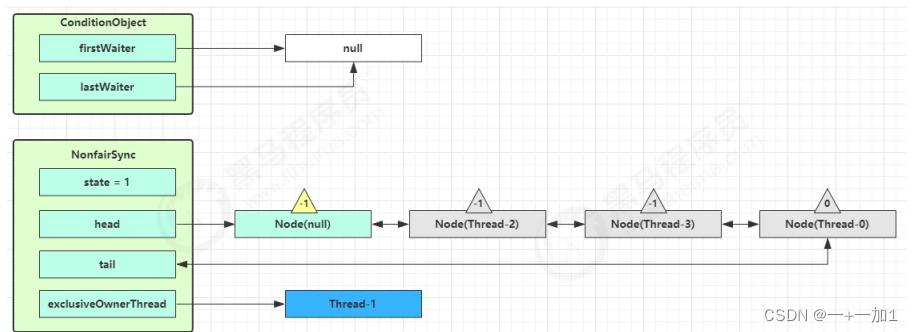
十六、读写锁原理
ReentrantReadWriteLock
StampedLock
十七、Semaphore 原理
(一)、acquire
- Semaphore 的构造方法(假设设置信号量为3)
public Semaphore(int permits) { sync = new NonfairSync(permits); }NonfairSync(int permits) { super(permits); }Sync(int permits) { setState(permits); }将state设置为3
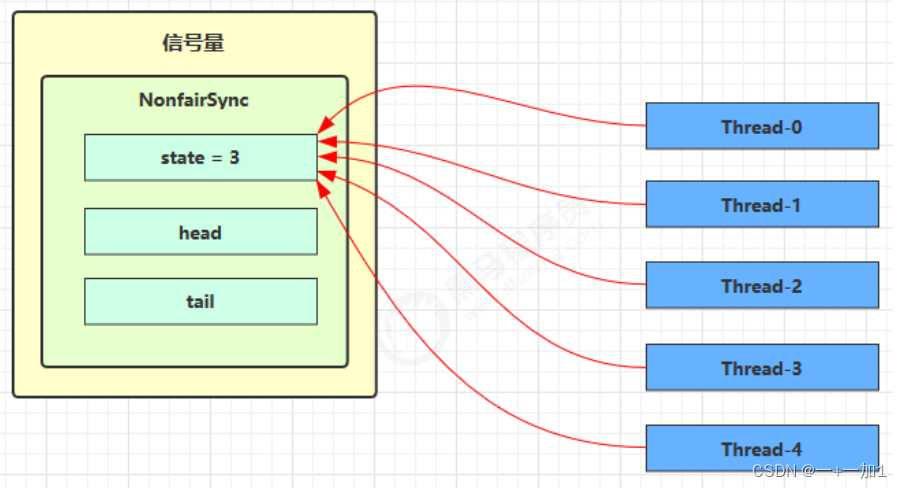
- 线程获得锁要调用acquire()方法
public void acquire() throws InterruptedException { sync.acquireSharedInterruptibly(1); }public final void acquireSharedInterruptibly(int arg) throws InterruptedException { if (Thread.interrupted()) throw new InterruptedException(); if (tryAcquireShared(arg) < 0) doAcquireSharedInterruptibly(arg); }进入tryAcquireShared(arg)
protected int tryAcquireShared(int acquires) { return nonfairTryAcquireShared(acquires); }final int nonfairTryAcquireShared(int acquires) { for (;;) { int available = getState(); //获得state = 3 int remaining = available - acquires; //state-1 if (remaining < 0 || compareAndSetState(available, remaining)) return remaining; //return 2 } }返回到
public final void acquireSharedInterruptibly(int arg) throws InterruptedException { if (Thread.interrupted()) throw new InterruptedException(); if (tryAcquireShared(arg) < 0) //返回值为2,加锁成功,结束 doAcquireSharedInterruptibly(arg); } - 假设Thread-1,Thread-2,Thread-4 cas 竞争成功,此时Thread-0竞争锁时
if (remaining < 0 || compareAndSetState(available, remaining)) return remaining; //return -1 }返回
public final void acquireSharedInterruptibly(int arg) throws InterruptedException { if (Thread.interrupted()) throw new InterruptedException(); if (tryAcquireShared(arg) < 0) //返回值为-1,加锁失败 doAcquireSharedInterruptibly(arg); }执行doAcquireSharedInterruptibly(arg); 与ReentrantLock 相似
private void doAcquireSharedInterruptibly(int arg) throws InterruptedException { final AbstractQueuedSynchronizer.Node node = addWaiter(AbstractQueuedSynchronizer.Node.SHARED); boolean failed = true; try { for (;;) { final AbstractQueuedSynchronizer.Node p = node.predecessor(); if (p == head) { int r = tryAcquireShared(arg); if (r >= 0) { setHeadAndPropagate(node, r); p.next = null; // help GC failed = false; return; } } if (shouldParkAfterFailedAcquire(p, node) && parkAndCheckInterrupt()) throw new InterruptedException(); } } finally { if (failed) cancelAcquire(node); } }thread-3也重复上述过程,最终阻塞

(二)、release
- Thread-4释放一个许可
public void release() { sync.releaseShared(1); }public final boolean releaseShared(int arg) { if (tryReleaseShared(arg)) { doReleaseShared(); return true; } return false; }进入
protected final boolean tryReleaseShared(int releases) { for (;;) { int current = getState(); //拿到当前锁状态 int next = current + releases; //suo状态加1 if (next < current) // overflow throw new Error("Maximum permit count exceeded"); if (compareAndSetState(current, next)) //尝试改变锁状态 return true; //返回true } }返回
public final boolean releaseShared(int arg) { if (tryReleaseShared(arg)) { doReleaseShared(); return true; } return false; }执行doReleaseShared();
private void doReleaseShared() { for (;;) { AbstractQueuedSynchronizer.Node h = head; if (h != null && h != tail) { int ws = h.waitStatus; if (ws == AbstractQueuedSynchronizer.Node.SIGNAL) { if (!compareAndSetWaitStatus(h, AbstractQueuedSynchronizer.Node.SIGNAL, 0)) continue; // loop to recheck cases unparkSuccessor(h); //唤醒线程 } else if (ws == 0 && !compareAndSetWaitStatus(h, 0, AbstractQueuedSynchronizer.Node.PROPAGATE)) continue; // loop on failed CAS } if (h == head) // loop if head changed break; } } - 接下来竞争锁的过程同上

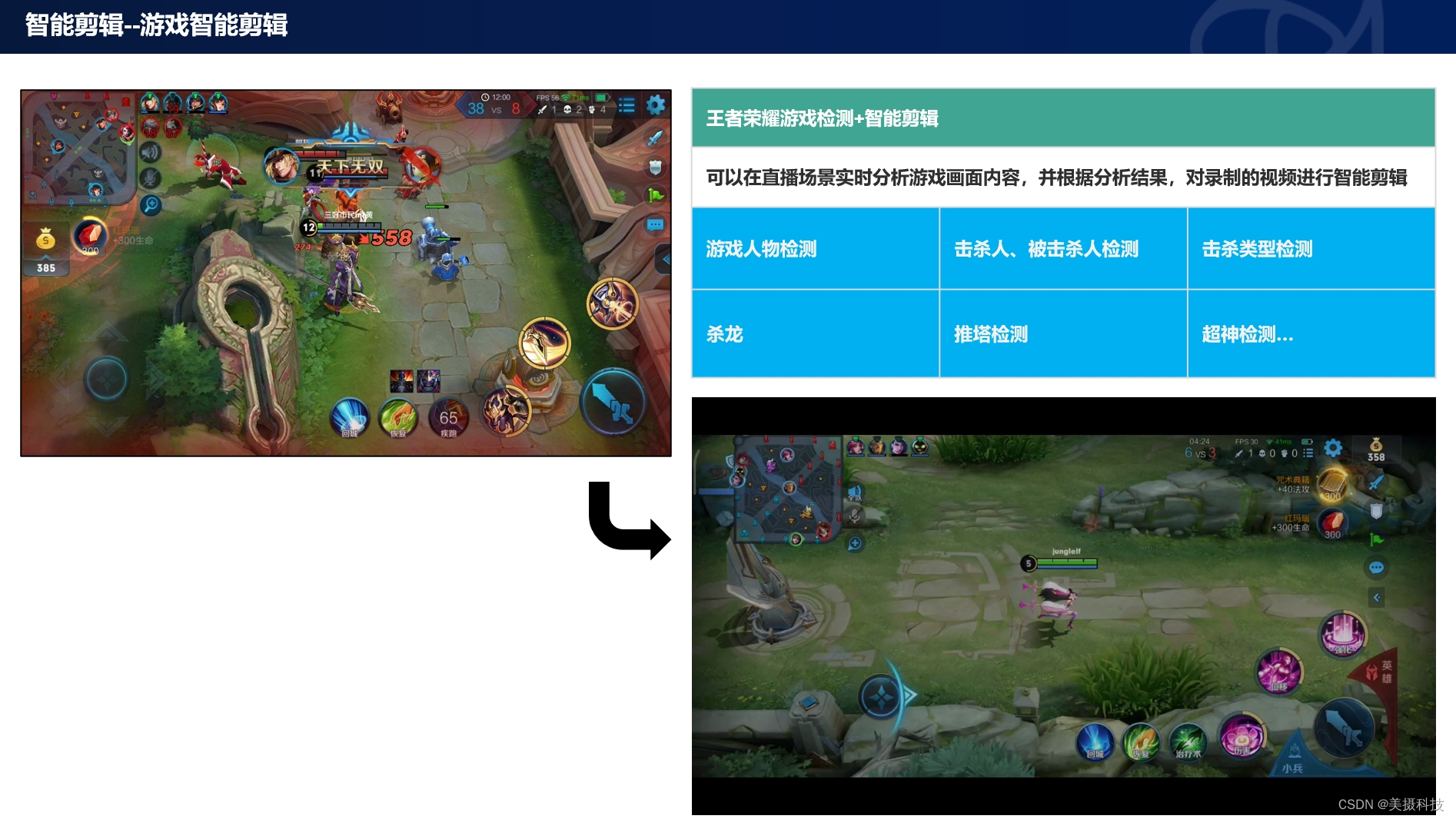

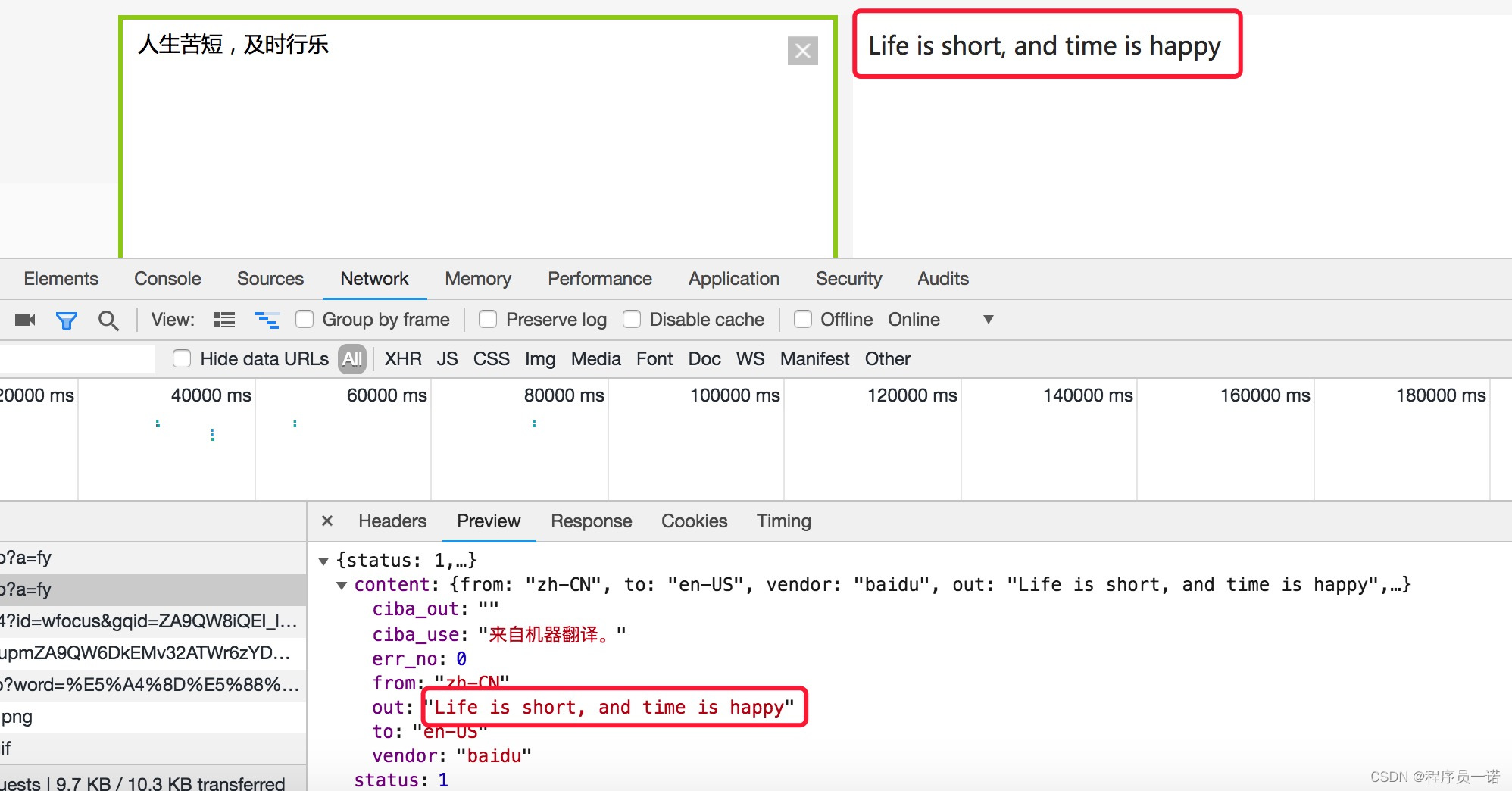
![[Python GUI PyQt] PyQt5快速入门](https://img-blog.csdnimg.cn/direct/dfab37ca62e24f6ea4a0eb9dde8626c6.png#pic_center)




